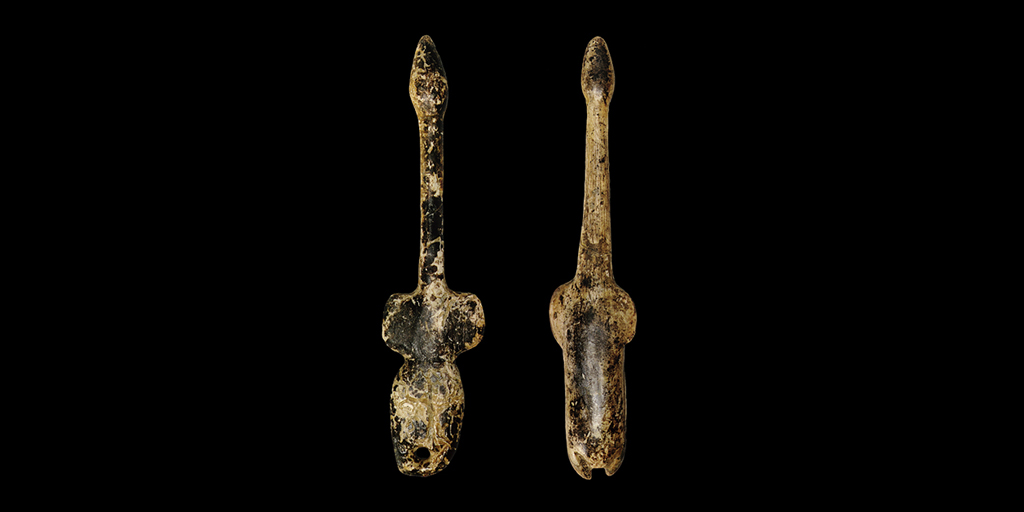


Mal'ta Flying Swan Pendants

Open site of Mal'ta, Irkutsk, Siberia.
Siberian Middle Upper Palaeolithic/Gravettian, 22,000-20,000 years old
Size: from 4.5 to 15 centimetres
The thirteen ivory bird pendants, discovered at Mal'ta in Siberia, are certainly waterfowl, probably swans or geese given their long elegant necks. The pendants are perforated for suspension at the end of the body.
Jill Cook describes the symbolic significance of these carved pendants in her book Ice Age Art - Arrival of the modern mind:
For six to seven months over winter, Lake Baikal is frozen. As the spring thaw comes, millions of water birds and waders arrive from Europe, South Asia and Australia to breed. Towards the end of August their return journey begins. Seeing the sky full of birds is one of the wonders of nature.
Mal'ta flying swan pendants from #Siberia - elegance & symbolism https://t.co/WZ6k5H2Nvp #archaeology pic.twitter.com/gyEuvx7RR1
— Bradshaw Foundation (@BradshawFND) March 21, 2017
Image: Chet Gottfried
For hunter-gatherers who have endured a hard winter the arrival of the migrants heralds the change of season and diet with a sudden glut of easily obtained meat and eggs that may give rise to feasts and ceremonies. If the first skeins of geese to show up cause great excitement, their departure marks the end of the holiday from the coldest conditions and the need to hasten preparations for winter. Added to the natural significance of these birds is the possibility that they may also be regarded as spirit helpers imbued with supernatural qualities, being able to fly to the Upper World, dive through the water to the Lower World and exist on land in the Middle World.
In other words, there may have been several reasons, including the aesthetic, to represent such birds and this is certainly evident in comparing the bone remains found on the site with the animals represented in the art. This shows that although the inhabitants of Mal'ta actually depended on reindeer, as well as fish, the only creature other than birds and perhaps snakes to be represented in their figurative art is the mammoth.
Visit the Art of the Ice Age:
http://www.bradshawfoundation.com/sculpture/index.php
Jill Cook Ice Age Art - Arrival of the modern mind
by Bradshaw Foundation
Monday 04 December 2023
by Bradshaw Foundation
Friday 30 June 2023
by Bradshaw Foundation
Thursday 06 April 2023
by Bradshaw Foundation
Thursday 24 November 2022
by Bradshaw Foundation
Tuesday 27 September 2022
by Bradshaw Foundation
Thursday 08 September 2022
by Bradshaw Foundation
Tuesday 19 July 2022
by Bradshaw Foundation
Monday 06 June 2022
by Bradshaw Foundation
Friday 11 March 2022
by Bradshaw Foundation
Wednesday 02 March 2022
by Bradshaw Foundation
Thursday 26 August 2021
by Bradshaw Foundation
Monday 16 August 2021
by Bradshaw Foundation
Tuesday 06 July 2021
by Bradshaw Foundation
Thursday 06 May 2021
by Bradshaw Foundation
Thursday 06 May 2021
by Bradshaw Foundation
Tuesday 16 March 2021
by Bradshaw Foundation
Monday 04 December 2023
by Bradshaw Foundation
Friday 30 June 2023
by Bradshaw Foundation
Thursday 06 April 2023
by Bradshaw Foundation
Thursday 24 November 2022
by Bradshaw Foundation
Tuesday 27 September 2022
by Bradshaw Foundation
Thursday 08 September 2022
by Bradshaw Foundation
Tuesday 19 July 2022
by Bradshaw Foundation
Monday 06 June 2022
by Bradshaw Foundation
Friday 11 March 2022
by Bradshaw Foundation
Wednesday 02 March 2022
by Bradshaw Foundation
Thursday 26 August 2021
by Bradshaw Foundation
Monday 16 August 2021
by Bradshaw Foundation
Tuesday 06 July 2021
by Bradshaw Foundation
Thursday 06 May 2021
by Bradshaw Foundation
Thursday 06 May 2021
by Bradshaw Foundation
Tuesday 16 March 2021
Friend of the Foundation











